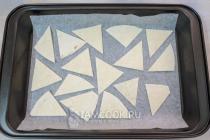It is sometimes hot in summer, and laptops do not tolerate heat very well and start to glitch if they lack cooling. In this article, we'll show you how to make your own laptop stand with a fan. This will cool the device and prevent burns on your feet.
To assemble the stand, you will need a piece of glass, plastic or plywood, a fan powered by 5 volts, a USB cable, screws and tools (glue, a drill with drills, a knife, a marker).
Create a base for the stand. To do this, cut out a rectangle from the workpiece the size of the base of the laptop or slightly larger. Attach legs 3-4 centimeters high. You can use glue and corners to attach them. Sand the edges so they are not sharp or scratched.

Mark the location of the fan with a marker. Place it where the vents are on the laptop. Punch lots of holes to vent air away from the fan, or simply cut a large hole with a jigsaw or heated knife.

Bolt on the fan and supply it with USB power. The fan will spin and cool the laptop. Even if the laptop has passive cooling, the extra air removal from the case in the warm season will benefit it. Such a stand can come in handy at other times of the year - when you run games or resource-intensive programs on your laptop.
If you wish, you can decorate the stand and equip it with LED backlighting, but keep in mind that the additional load on the USB will increase the power consumption and, as a result, the heating of the device.
How do I cool my laptop at home?
4.8 (96.35%) 104 votesAny laptop heats up to some extent during operation. Especially often, overheating of this technique occurs in the summer, when the temperature the environment rises. A similar overheating is also observed when modern computer games... In order to protect the equipment from the critical temperature, temperature sensors are initially installed in it. When the temperature indicators of the central or GPU reach a critical value, the device simply turns off. But this is not always convenient, especially if at the time of shutdown you were performing important actions on your device.
Overheating reasons
In order to cope with overheating problems, you need to find their cause and try to fix it.
- The main reason for laptop overheating lies in its dimensions, namely in the compactness of the case. In it, manufacturers place all the same components that are available in an ordinary desktop computer. The challenge, however, is to maintain the performance of the device. To accomplish this, the hardware items are packed fairly tightly in the case. There is very little free space between them. This interferes with the full-fledged movement of air, the meaning of which is to remove hot streams to the outside and the flow of cold ones to the inside. The compactness of laptops does not allow equipping them with large and powerful coolers.
- An additional inconvenience when using a laptop is dust, lint, hair, wool and other small light particles that periodically accumulate in places where air is blown out and on the radiator. Because of this, the performance of the device is reduced, in particular, the thermal conductivity. In this case, the cooler becomes clogged, and its efficiency decreases.
Summer has come, and the owners of laptop computers are increasingly asking the question: "how to cool a laptop" if it gets pretty hot after a certain time of operation
- Sometimes the cause of overheating of your device is a malfunction of the fan caused by its breakdown or factory defect. For example, it may turn out to be insufficiently lubricated or a bearing is faulty.
- During long-term operation of the device, thermal paste may dry out, with the help of which the best heat transfer to the cooler and radiator is produced, enabling the fan to function more efficiently.
- Some laptop owners misuse them. For example, you can often observe how at home the device is not installed on a hard surface, but on a blanket or placed directly on your knees. In these cases, overheating of the device cannot be avoided, because the openings for heated air blowing are closed, and the processor cannot fully cool down.
An expert opinion: how to cool a laptop at home?
Most effective method to lower the temperature inside is to replace the thermal paste. It is advisable to carry out this procedure regularly. It is also worth remembering that the best remedy for overheating is prevention: place the laptop only on hard surfaces (and it would be best to purchase a special cooling pad) and do not forget to clean it from dust.
Konstantin Kotovsky
About symptoms
To determine the temperature of the laptop, use special programs... If you suspect that your device is overheating, refer to the data that displays the temperature sensor measurements. For example, you can use BIOS / UEFI or the HWInfo utility to find out the required information. You can find any other program that will show you the heating of your computer by displaying sensor data. In a special window, you can also monitor the rotational speed of the cooler.
In the operating manual, you can find information about the permissible temperature range of the device. These data are also available on the official website of the company that sells laptops.
But it is not necessary to resort to utilities when determining the permissible operating temperature of a small-sized computer.

When the temperature limit of the CPU / GPU is reached, the device will simply turn off
If it overheats, then it will be immediately clear by the following signs:
- too loud noise from the fan;
- the air being blown out is very hot;
- abrupt shutdowns laptop;
- hot case.
Consequences of high temperatures
If you ignore the constant overheating of your laptop, this can lead to unpleasant consequences. For example, high temperatures have a negative effect on the processor. The crystalline structure of its components is gradually deteriorating, negatively affecting its performance.
You probably noticed that an overheated microprocessor starts to "slow down", slowly performing tasks. In this case, the owner of the device can see error messages on the screen. Some processes may be invisible to the user. Sometimes, when overheating, the processor needs to perform calculations several times until it gets the correct result.
But this situation can be especially inconvenient for gamers who are fond of online games with detailed graphics. The high temperature inside the laptop provokes the shutdown of the device right during some important "battle". Often such nuances make the gaming community ask the question: "how to cool the laptop?", And resort to sophistication for the sake of good cooling.
But the negative thermal factor adversely affects not only the crystal structure of the microprocessor. After all, silicon involved in the operation of transistors is also susceptible to carbonization, like contacts. This provokes even greater overheating and easily disables the device in just a few months.

Typically, a laptop is not in danger of failure due to overheating, because it has temperature sensors
Ways to eliminate factors provoking overheating
Laptop stands
There are many different laptop stands available today. They differ in the presence or absence of an additional cooling cooler. Both of them allow you to reduce the temperature of the processor. Such devices are sometimes quite inexpensive and available to everyone.
Cleaning software
For more than 4 years now I have been using a laptop as a replacement for a desktop. After switching to a laptop, a couple of very significant drawbacks were noticed for me: prolonged work under load causes quite a lot of heating of the main components and the surface of the laptop and the fact that the screen level is below the comfort zone. Having suffered a bit like this, at the beginning of 2009 a stand of 4 mm plexiglas with 2 120 mm fans was quickly concocted.
As time went on, and in November 2011, I changed my old man, Acer TravelMate 5520, to the more modern Acer Aspire 5750. The old stand did not fit the new laptop a little in terms of ventilation holes, angle of inclination, and besides, the bent legs were tired and cracked ... So it was decided to make a new, improved one.
At first there was an idea to make it from 2-3 mm aluminum sheet, but the search for a suitable material with reasonable price was unsuccessful. The next idea was to use the cover from the old computer case... At the local flea market there was an old AT case with a U-shaped cover of suitable dimensions.
To begin with, everything was once again measured, estimated and planned. in order not to severely damage the paint in the places where it was cut with a jigsaw, masking tape was glued.

It's good that one wall still remains from the U-shaped lid with which, after the second time, it was still possible to cut and drill everything correctly:

After preliminary grinding it turned out:


This was followed by cleaning and painting with black matte paint in thin 4 layers. It immediately became clear that I sanded it a little carelessly - in some places you can see scratches from the sandpaper, and all due to the fact that I was in a hurry. But still I did not redo it, since this place will still be under the bottom of the laptop.
A fan speed regulator was also assembled based on the LM2940 voltage stabilizer (similar circuit), the voltage adjustment range at the input 11.82V was from 5.24V to 11.62V, the rubber feet were borrowed from the mixer repair kit and put on double-sided tape. The fans I used were 135mm Scythe Slip Stream (SM1425SL12H), which were bought cheap over a year ago. The stand is powered by an external 12V 1.5A power supply. The result is the following device:





The temperature drop with a cursory measurement on the processor was 7-10 degrees on the video card 8-13.
The project turned out to be very extended in time due to lack of time and opportunities, but in the end it was finally completed and met expectations.
vGamBIT, people.overclockers.ru
Good day to all! This time I want to tell you about the laptop cooling cooler. I invite all the most interesting under the cat.
Before I explain everything to you on the shelves, I would like to wish all Muskovo citizens a Happy New Year and Christmas, I wish you all good luck, good health and good karma!
Now let's move on to our review. Everyone who has a laptop is faced with such a problem as strong heating under load with all sorts of programs. I almost always use a laptop, for work, surfing the Internet, playing games in my free time, and so on. At the moment of load on my laptop, the fan runs at maximum speed and this place is very hot, you can even make coffee. I decided to buy a cooling pad, the sense from it is zero plus inconvenient, I just threw the money down the drain. After long thinking, I decided to take this little thing:

The kit includes: the cooler itself, a usb wire, silicone nozzles for different types gratings, a plastic stand with suction cups to it and a small piece of glue, instructions.
I liked it very much appearance, backlit thermometer. At first I thought that the logo (spider) was also highlighted, but it turned out to be just a picture. The cooler operates in two modes: maximum and minimum power. To turn it on, you need to click on the white round button... The button will light up in green and the operating indicator will turn on, when pressed again, the minimum power will turn on, the button will light up in blue. The third press will turn it off. The backlit temperature indicator always works.

As you can see in the photo, the silicone nozzle fits snugly against the grill, which contributes to a better flow of hot air into the device. I did not install an additional mount, since the legs of the laptop are small, it will not even fit under it.
This is how it looks on my desk:

Advantages
It is very convenient, does not take up much space and cools much better than a regular stand due to the fact that the cooler sucks and cools the air at the outlet faster, which contributes to greater air intake from the bottom. The backlit thermometer constantly informs about the temperature of the blown air, the backlight is not bright but not dark, it does not hurt the eyes. The set includes many attachments for your mesh.
I take temperature measurements using the speedfan program, plus we write down the readings of the built-in sensor. Opera, Skype, torrent and other trifles are running on the laptop, that is, the system is not particularly loaded right now
Test # 1. Without cooling (on a thermometer 39s) 
Test number 2. Minimum revolutions (on a thermometer 28.5s) 
Test number 3. Maximum revolutions (on a thermometer 24.5s) 
The results are very good, one might even say excellent, the temperatures with and without cooling are very different from each other. The error of the thermometer was 1-2 s. The test of each level of work took 15 minutes (that is, I didn’t immediately bring it in and the tyap-blooper made the results, I waited a long time and took screenshots of the average temperature readings). I think, at maximum load, this horse will cope with its task (who would like to know, write in the comments, I will issue the fourth test). My old stand only cooled for 2-3s
disadvantages
Well, what about without them ... The downside is that the fan is too noisy at maximum speed, almost like a small hairdryer, and the price tag is too high - 14 bucks is not huhrymukhry for that. But despite its high efficiency, I think it is worth it to be bought (but not for 14, at least for 11-12 $ the course you know which one is now).
P.S I didn't dismember because the screws are located under the legs, and I had to tear everything off and unscrew it, so excuse me :)
I plan to buy +32 Add to favourites I liked the review +27 +71DIY cooled laptop stand speeds up your device and prevents constant freezes and disconnection.
Cooler does not have to be bought in specialty stores.
Such an uncomplicated and very useful design can be assembled on your own, spending the minimum amount.
Using a laptop, users can work anywhere, because the device is easy to move. For supporting normal work device, adhere to the following recommendations:
Content:Paper hopper stand
One of the simplest and available ways to create a cooler with your own hands is an option using stationery.
On the shelves of any supermarket, you can find flat paper holders made of metal mesh. The price of such a tray does not exceed 300 rubles.
To design your unique system to cool the laptop, we need a stand of approximately the following shape:
Select the dimensions of the product individually, based on the size of your gadget. The advantage of such a stationery part is that it can change shape.
If you can't find a flat stand, use a different one. With a little effort, change its shape and proceed to further work.
Take a regular pan support and cut a circle along its diameter in the center of the tray:

Rice. 3 - creating a hole in the cooler
Now you need to attach a stand for kitchen utensils to the resulting circle.
You can also buy it at any household goods store (the cost varies between 40-100 rubles). We advise you to choose the metal version.
You should get a structure like this:

Rice. 4 - fastening of elements
Now take the fan mechanism. It is purchased separately from a computer store. An ordinary plastic part will not cost more than 200 rubles.
It consists of a rotating element and, through which we will connect the resulting one to the laptop. Secure it underneath the tray with bolts.

Rice. 5 - installation of the fan mechanism
As a result, we get an excellent laptop cooling system from improvised elements, which in its characteristics is in no way inferior to store devices for several thousand rubles.
You can also choose the power and speed of air circulation yourself at the stage of purchasing a ventilation mechanism.
Simple styrofoam and homemade fan design
This method is suitable for those who want to save as much as possible, because the resulting fan will cost you several tens of rubles, and you can make it from any bottle and a piece of foam.
The base of the structure will consist only of foam.
In order for the product to last longer, we advise you to take dense extruded foam or expanded polystyrene (sold in any hardware store).
Cut it to fit your laptop.
The cooler design should not be in contact with the table surface. It is advisable to make 4 more small figures out of polystyrene, on which the product will stand.
This will provide better air circulation.
Note that the correct position of the cooler implies a slight inclination towards the user, so make one leg pore 3 centimeters high and the other two centimeters high.
Accordingly, the first two parts will be the back support.

Rice. 6 - creating a frame for the stand
You can fasten foam parts to each other using simple PVA glue or superglue
Wait until the attachment is completely dry before proceeding with the next stages of work.
Cut 4 more small squares and attach them to the corners of the upper part of the cooler to get this look:

Figure 7 - creating the front part of the cooler frame
When you place your laptop on top of the product, it will not stick to the frame, creating more space for airflow.
All 4 small squares must be the same height. As shown in the picture above.
Now we need to create a ventilation mechanism. It will be made of regular plastic. Take any bottle, cut off its top and create the following detail:

Rice. 8 - creating a fan
The resulting element will become the base of the fan. In order for the blades to spin, forming a directed air flow, it is necessary to slightly change the shape.
To do this, take a candle and light it. Bring the fan to a fire and warm up the base of each blade by twisting them in one direction at once:

Rice. 9 - shaping the blades
Punch a hole in the center of the cooling system based on the size of the fan.
If the blades turn out to be too long, cut them off, and again go around the edges with fire to smooth them out.
Take 4 ice cream sticks and secure them to serve as a support for the ventilation element. You can fasten the sticks together using ordinary adhesive tape.
It is better not to use glue. Position the fan as shown below.

Rice. 10 - creating a cooling structure
Take a simple motor mechanism (available in any electronics store) and attach a bottle cap to the outside of it. Place the resulting part in the center of the blades:

Rice. 11 - creating cooling
Take the USB cable and solder it to the motor. The construction is ready. Now you can design by painting in any color.

Fig. 12 - checking the operation of the device
4 ways to cool your laptop without a cooler
Advanced users can easily upgrade their laptop so that it breathes better and cools faster.
There are 4 common life hacks that can help you cool your laptop without using a special stand:
- Remove all covers from openings that let air in ... Thus, the air will circulate inside the laptop much faster and the fan will distribute it evenly to the surface. motherboard and the central processor.
Take off back cover laptop and just peel off all the metal meshes that are located on the air intake grilles;
- Mechanical cleaning of the fan. In 90% of cases, it is precisely in other fine particles.
Even the best cooling stand cannot help a laptop perform better if the inside of the device is full of dust.
It is necessary to open the laptop yourself or with the help of a specialist and clean the part using dry a cotton swab or brush.
After cleaning the component, it follows - a substance that is applied to the surface of the parts of the motherboard (usually a video card and processor) to improve heat transfer between them.
Over time, the existing paste layer becomes unusable.
After mechanically cleaning the built-in cooling system, you will immediately notice an improvement in the performance of your PC. It will no longer overheat and freeze.

Fig. 13 - cleaning the fan of the device
- Cleaning the fan processor. If the structure of the laptop allows, it is necessary not only to clean the fan, but also to take it out of the case and disassemble it. Then you should wipe each of its elements separately, because even inside the part itself, a huge amount of dirt accumulates;
DIY laptop cooling pad
DIY cooling laptop stand














